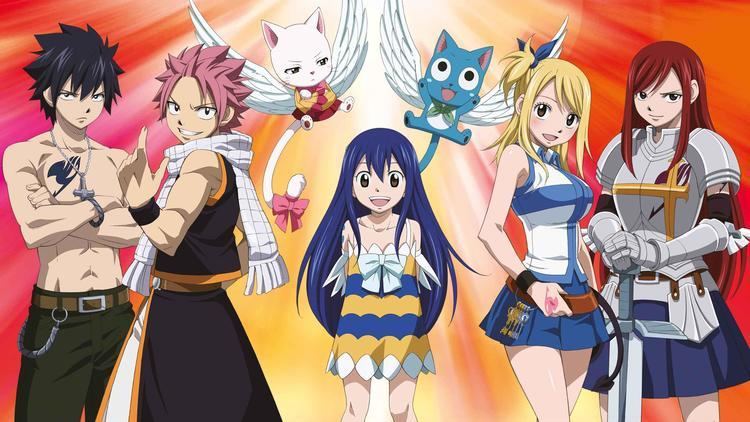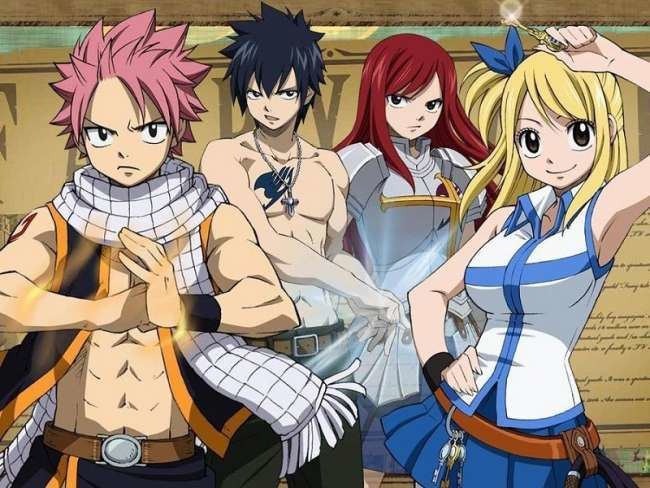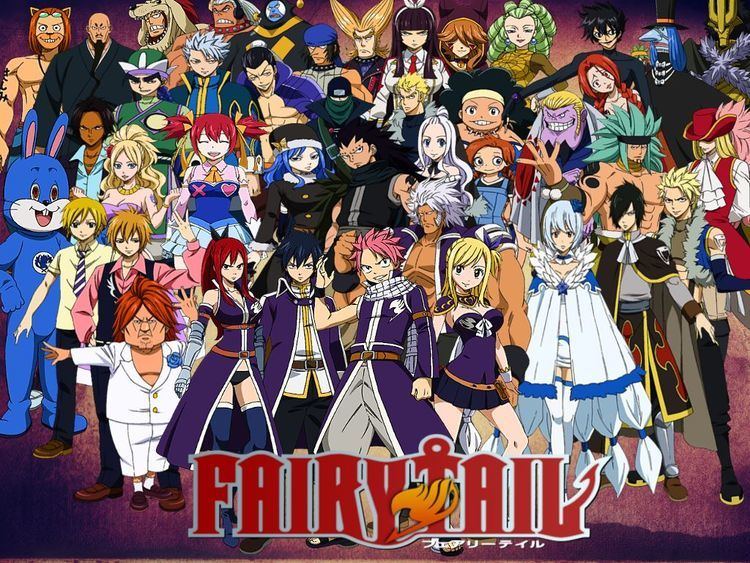Written by Hiro Mashima Demographic Shōnen Magazine Weekly Shōnen Magazine | Published by Kodansha Directed by Shinji Ishihara Creator Hiro Mashima | |
 | ||
English publisher Del Rey Manga (#1 – 12)Kodansha Comics USA (#13 –ongoing) Original run August 2, 2006 – present Adaptations Fairy Tail the Movie: Phoenix Priestess (2012) Genres Action fiction, Adventure fiction, Comedy, Fantasy Studios A-1 Pictures, Manga Entertainment Publishers Del Rey Manga (#1 – 12, NA), Kodansha USA (#13 –ongoing), Kodansha Similar One Piece, Naruto, Attack on Titan, The Seven Deadly Sins | ||
Fairy Tail (Japanese: フェアリーテイル, Hepburn: Fearī Teiru) is a Japanese manga series that is written and illustrated by Hiro Mashima. It has been published in Weekly Shōnen Magazine since August 2, 2006, and has been published by Kodansha in 59 tankōbon volumes; the individual chapters are being published in tankōbon volumes by Kodansha, with the first released on December 15, 2006, and the 59th volume released on December 16, 2016. Fairy Tail follows the adventures of Natsu Dragneel, a teenage wizard (魔導士, madōshi) who is a member of the popular wizards' guild Fairy Tail, as he searches for the dragon Igneel.
Contents

The manga has been adapted into an anime series produced by A-1 Pictures, Dentsu Inc., and Satelight, which began broadcasting in Japan on October 12, 2009. Additionally, A-1 Pictures has developed seven original video animations and two animated feature films. The series ended its initial run on March 30, 2013. A second series premiered on TV Tokyo on April 5, 2014, and ended on March 26, 2016.

Fairy Tail was originally licensed for an English language release in North America by Del Rey Manga, which began releasing the individual volumes on March 25, 2008 and ended its licensing with the 12th volume release in September 2010. In December 2010, Kodansha Comics USA took over North American release of the series. The Southeast Asian network Animax Asia aired an English-language version of the anime for seven seasons from 2010 to 2015. The anime has been licensed by Funimation for an English-language release in North America. As of February 2017, Fairy Tail has 60 million copies in print.

Plot

The fictional world of Earth-Land (アースランド, Āsu Rando) is populated by wizards who coalesce into guilds to hone their magical abilities and apply them for paid job requests. Seventeen-year-old wizard Lucy Heartfilia runs away from home to join Fairy Tail, a wizards guild famous for its members' overly destructive antics. She is invited into the guild by Natsu Dragneel, a wizard with dragon-like abilities who travels the kingdom of Fiore (フィオーレ王国, Fiōre Ōkoku) in search of his missing foster father, the dragon Igneel. Natsu forms a team with his cat-like companion Happy and Lucy, later to be joined by ice wizard Gray Fullbuster and armored wizard Erza Scarlet. The five embark on numerous guild missions, which include subjugating criminals, illegal dark guilds, and ancient Etherious (エーテリアス, Ēteriasu) demons created by the dark wizard Zeref.

Several of Fairy Tail's members encounter the immortal Zeref on the guild's sacred ground of Sirius Island (天狼島, Tenrō-jima). A conflict over Zeref ensues between Fairy Tail and the dark guild Grimoire Heart, which attracts the attention of the evil black dragon Acnologia. The Fairy Tail wizards survive Acnologia's assault when the spirit of Mavis Vermillion, their guild's founder, puts them into seven years of suspended animation with her defensive spell, while Zeref leaves the island to ruminate over his next course of action during this time.
Shortly after the missing wizards return, Fairy Tail participates in the Grand Magic Games (大魔闘演武, Daimatōenbu), a tournament held to determine the strongest guild in the country. In doing so, they prevent a time travel conspiracy by a future counterpart of Rogue Cheney, one of the rival competitors, to ravage the kingdom with dragons brought from the past. Zeref, observing these events, decides to eradicate humanity for their continuing conflicts. He thus oversees a battle between Fairy Tail and Tartaros, a dark guild of Etherious demons who aim to unseal E.N.D., Zeref's ultimate demon. Acnologia returns to annihilate both guilds, but is stopped when Igneel emerges to battle him, revealed to have sealed himself within Natsu. The wizards defeat Tartaros while Igneel is killed by Acnologia, whom Natsu vows to defeat and avenge Igneel's death.
One year later, Natsu returns from a training journey to discover that Fairy Tail's master Makarov Dreyar has been staving off an invasion by the Alvarez Empire, a military nation ruled by Zeref. During their battle with Zeref's army, Natsu discovers his origins as Zeref's younger brother, whom the immortal dark wizard reincarnated as E.N.D. (Etherious Natsu Dragneel) out of a desire to die. Realizing his and Zeref's lives are intertwined, Natsu overcomes his demonic transformation by asserting his identity as a human, allowing him to battle Zeref without dying.
Production
After finishing his previous work, Rave Master, Hiro Mashima found the story sentimental and sad at the same time, so he wanted the storyline of Fairy Tail to have a "lot of fun [for everyone]". His inspiration for the series was simply sitting in bars and partying with his friends, the community aspect. Having always loved magicians and wizards, he imagined what it would be like if he and his friends were magicians. But it is also about young people finding their calling, such as a job. He stated that while he tries to consider both his own interests and the fans' on what will happen next in Fairy Tail, the fans' take precedence.
Mashima described his weekly schedule for creating individual chapters of Fairy Tail in 2008. Script and storyboards are written on Monday, rough sketches the following day, and drawing and inking are done Wednesday through Friday. At the time the weekends were for Monster Hunter Orage, a monthly series Mashima was writing at the same time as Fairy Tail. He usually thinks up new chapters while working on the current ones. Mashima had six assistants in 2008 that worked in an 8,000 sq. feet area with seven desks, as well as a sofa and TV for video games. In 2011, he stated that he worked six days a week, for 17 hours a day.
For the characters of the series, Mashima drew upon people he has known in his life. In establishing the father-son relationship between Natsu and Igneel, Mashima cited his father's death when he was a child as an influence. He based Natsu's motion sickness on one of his friends, who gets sick when taking taxis together. When naming the character, the author thought western fantasy names would be unfamiliar to Japanese audiences, so he went with the Japanese name for summer; Natsu. Mashima based the humorous aspects of the series on his daily life and jokes his assistants would make.
Manga
Written and illustrated by Hiro Mashima Fairy Tail has been serialized in the manga anthology Weekly Shōnen Magazine beginning on August 2, 2006. The individual chapters have been collected and published into tankōbon volumes by Kodansha since December 15, 2006. There are a total of 524 chapters and 59 tankōbon volumes. A special in Weekly Shōnen Magazine featured a crossover with Flunk Punk Rumble, released in 2008. The official fanbook, Fairy Tail+, was released on May 17, 2010 in Japan. Another crossover with Mashima's first series Rave was published in 2011. A special issue of Weekly Shōnen Magazine, published on October 19, 2013, featured a small crossover between Fairy Tail and Nakaba Suzuki's The Seven Deadly Sins, where each artist drew a yonkoma (four-panel comic) of the other's series. An actual crossover chapter between these two ran in the magazines' combined 4/5 issue of 2014, which was released on December 25, 2013.
The series was licensed for an English-language release in North America by Del Rey Manga. The company released the first volume of the series on March 25, 2008 and continued until the release of the 12th volume in September 2010. After Del Rey Manga shut down, Kodansha Comics USA acquired the license and began publishing Fairy Tail volumes in May 2011. 56 English-language volumes have been published.
Spin-off manga
Five spin-off manga series based on Fairy Tail have been released. The first two series—Fairy Tail Zero by Mashima and Fairy Tail: Ice Trail by Yūsuke Shirato—were released with the launch of a monthly magazine titled Monthly Fairy Tail Magazine on July 17, 2014, and ended in the magazine's final issue published on July 17, 2015. A third series, Fairy Tail Blue Mistral by Rui Watanabe, ran in Kodansha's shōjo manga magazine Nakayoshi from August 2, 2014 to December 1, 2015, while another, Fairy Girls by Boku, was released in Kodansha's Magazine Special from November 20, 2014 to August 20, 2015. Kyōta Shibano created a three-part meta-series titled Fairy Tail Gaiden, which was launched in Kodansha's free weekly Magazine Pocket mobile app. The series began in 2015 with Twin Dragons of Saber Tooth from July 30 to November 4, continued with Rhodonite from November 18, 2015 to March 30, 2016, and concluded with Flash of Great Lightning in 2016 from May 4 to September 14.
Fairy Tail Zero, Ice Trail, Blue Mistral, Fairy Girls, and the first two installments of Gaiden are all licensed for English release by Kodansha Comics USA.
Anime
A-1 Pictures, Dentsu Entertainment, and Satelight produced an anime adaptation of the manga. The anime, also titled Fairy Tail and directed by Shinji Ishihira, premiered on TV Tokyo on October 12, 2009. The series ended its run on March 30, 2013, with reruns beginning to air on April 4, 2013 under the title Fairy Tail Best!. The series started back again on April 5, 2014 and ended on March 26, 2016. Forty-one DVD volumes containing four episodes each have been released. The Southeast Asian network Animax Asia aired the series locally in English. On January 18, 2011, British anime distributor Manga Entertainment announced on Twitter that the company would release the anime series in bilingual format at the end of the year. On April 21, 2011, they had confirmed that the first volume with 12 episodes would be released in February 2012; however, they later announced that the first volume would be released on March 5, 2012. In 2011, North American anime distributor Funimation Entertainment announced that they had acquired the first season of the ongoing series. The series made its North American television debut on November 22, 2011 on the Funimation Channel. The anime is also licensed by AnimeLab in Australia and New Zealand Melanesian Region (Fiji, Papua New Guinea, Solomon Islands and Vanuatu), Polynesian Region (Cook Islands, Niue, Samoa, Tonga, and Tuvalu), and was simulcast on their website as it aired in Japan.
Sequels
On March 4, 2013, Mashima announced on his Twitter account that the anime would not end yet, and confirmed on July 11 that a sequel series was greenlit. The sequel series was officially confirmed in Weekly Shonen Magazine on December 28, 2013 with a special edition chapter. The sequel is produced by A-1 Pictures and Bridge, featuring character designs by Shinji Takeuchi; the original series' voice actors also returned to the project along with director Shinji Ishihira and writer Masashi Sogo. The official website for the sequel was launched on January 7, 2014. The series premiered on TV Tokyo on April 5, 2014, and was being simulcast by Funimation Entertainment. The second series concluded its run on March 26, 2016. On March 22, 2016 Mashima announced once again via Twitter that a new Fairy Tail series is in the works.
Original video animation
Six original video animations (OVAs) of Fairy Tail have been produced and released on DVD by A-1 Pictures and Satelight, each bundled with a limited edition tankōbon volume of the manga. The first OVA, Yōkoso Fairy Hills!! (ようこそフェアリーヒルズ!!, lit. "Welcome to Fairy Hills!!"), is an adaptation of the manga omake of the same name, and was released with Volume 26 on April 15, 2011. The second, Yōsei Gakuen: Yankee-kun to Yankee-chan (妖精学園 ヤンキー君とヤンキーちゃん, lit. "Fairy Academy: Yankee-kun and Yankee-chan"), is also an adaptation of the omake of the same name, and was released together with Volume 27 on June 17, 2011. The third, "Memory Days" (メモリーデイズ, Memorī Deizu), was released together with Volume 31 on February 17, 2012, and features an original story written by series creator Hiro Mashima. The fourth, Fairies' Training Camp, is based on chapter 261 of the manga, and was released with Volume 35 on November 16, 2012. The fifth, Dokidoki Ryuzetsu Land (ドキドキ・リュウゼツランド, Dokidoki Ryuzetsurando, lit. "Exciting Ryuzetsu Land"), is based on chapter 298 of the manga and was released with Volume 38 of the manga on June 17, 2013. A sixth OVA, titled Fairy Tail x Rave (フェアリーテイル x レイヴ, Fearī Teiru x Reivu), is an adaptation of the omake of the same name and was released on August 16, 2013, with Volume 39 of the manga.
Film
An anime film adaptation of Fairy Tail, titled Fairy Tail the Movie: Phoenix Priestess, was released on August 18, 2012. It was directed by Masaya Fujimori, and its screenplay was written by anime staff writer Masashi Sogo. Series creator Hiro Mashima was involved as the film's story planner and designer for guest characters appearing in the film. To promote the film, Mashima drew a 30-page prologue manga "Hajimari no Asa" (はじまりの朝, lit. "The First Morning"), which was bundled with advance tickets for the film. The DVD was bundled with a special edition release of Volume 36 of the manga on February 13, 2013, and included an animated adaptation of "Hajimari no Asa" as a bonus extra. The film was aired on Animax Asia on March 23, 2013. Funimation has licensed North American distribution rights to the film. The English dub premiered at Nan Desu Kan on September 13, 2013, and was released on Blu-ray/DVD on December 10, 2013.
A second anime film was announced on May 15, 2015. On December 31, 2016, the official title of film was revealed as Fairy Tail: Dragon Cry, which is scheduled to be released on May 6, 2017 in Japan.
Video games
An action video game for the PlayStation Portable, titled Fairy Tail: Portable Guild (フェアリーテイル ポータブルギルド, Fearī Teiru: Pōtaburu Girudo), was unveiled at the 2009 Tokyo Game Show. The game was developed by Konami and was released on June 3, 2010. Two sequels to Portable Guild have also been released for the PlayStation Portable—the first, subtitled Portable Guild 2, was released on March 10, 2011; the second, Fairy Tail: Zeref Awakens (フェアリーテイル ゼレフ覚醒, Fearī Teiru: Zerefu Kakusei), was released on March 22, 2012. Two fighting games, Fairy Tail: Fight! Wizard Battle (フェアリーテイル 激闘! 魔道士決戦, Fearī Teiru: Gekitō! Madōshi Kessen) and Fairy Tail: Attack! Kardia Cathedral (フェアリーテイル 激突! カルディア大聖堂, Fearī Teiru: Gekitotsu! Karudia Daiseidō), were released for the Nintendo DS on July 22, 2010 and April 21, 2011, respectively. The characters Natsu and Lucy also appeared in the crossover video game Sunday VS Magazine: Shūketsu! Chōjō Daikessen as playable characters.
Audio
The music for the anime was composed and arranged by Yasuharu Takanashi. Four original soundtrack CDs have been released, containing music from the anime: the first soundtrack volume was released on January 6, 2010, the second volume on July 7, 2010, the third soundtrack volume on July 6, 2011, and the fourth soundtrack volume on March 20, 2013. Character song singles were also produced; the first single, featuring Tetsuya Kakihara (Natsu) and Yuichi Nakamura (Gray) was released on February 17, while the second single, featuring Aya Hirano (Lucy) and Rie Kugimiya (Happy), was released on March 3, 2010. Another character song album, entitled "Eternal Fellows," was released on April 27, 2011. Two of the songs from the album, performed by anime cast members Tetsuya Kakihara (Natsu) and Aya Hirano (Lucy), were used for both OVAs as the opening and ending themes, respectively. Other songs on the volume are performed by Yuichi Nakamura (Gray), Sayaka Ohara (Erza), Satomi Satō (Wendy), Wataru Hatano (Gajeel), and a duet by Rie Kugimiya (Happy) and Yui Horie (Carla).
An internet radio program began airing on HiBiKi Radio Station on February 11, 2012, featuring anime voice actors Tetsuya Kakihara (Natsu) and Mai Nakahara (Juvia) as announcers.
Manga
As of July 2016, the Fairy Tail manga had 35 million collected volumes in circulation. According to Oricon, Fairy Tail was the eighth best-selling manga series in Japan for 2009, fourth best in 2010 and 2011, fifth best of 2012, dropped to ninth in 2013, to 17th in 2014, and was 15th in 2015. The fifth volume of Fairy Tail was ranked seventh in a list of the top ten manga, and the series once again placed seventh after the release of the sixth volume. About.com's Deb Aoki listed Fairy Tail as the Best New Shōnen Manga of 2008. It also won the 2009 Kodansha Manga Award for shōnen manga. At the 2009 Industry Awards for the Society for the Promotion of Japanese Animation, the organizers of Anime Expo, Fairy Tail was named Best Comedy Manga. Volume 9 of the series was nominated in the Youth Selection category at the 2010 Angoulême International Comics Festival.
Reviewing the first volume, Carl Kimlinger of Anime News Network felt Fairy Tail followed standard shōnen action manga tropes, writing "the mix of goofy humor, face-crushing action, and teary-eyed sap is so calculated as to be mechanical." Carlo Santos, also of Anime News Network, agreed in his review of volume three; having positive views towards the art, particularly the action scenes, but citing a lack of story and character development. By volume 12 Santos suggested that Mashima's true talent lies in "taking the most standard, predictable aspects of the genre and somehow still weaving it into a fun, fist-pumping adventure."
Kimlinger, his colleague Rebecca Silverman, and A.E. Sparrow of IGN all felt Mashima's artwork had strong similarities to Eiichiro Oda's in One Piece. While Sparrow used the comparison as a compliment and said it had enough unique qualities of its own, Kimlinger went so far as to say it makes it difficult to appreciate Mashima's "undeniable technical skill."
Anime
The anime has also received a positive response from critics and viewers alike. In Southeast Asia, Fairy Tail won Animax Asia's "Anime of the Year" award in 2010. In 2012, the anime series won the "Meilleur Anime Japonais" (best Japanese anime) award and the best French dubbing award at the 19th Anime & Manga Grand Prix in Paris, France.
In reviewing the first Funimation Entertainment DVD volumes, Carlo Santos of Anime News Network praised the visuals, characters, and English voice acting, as well as the supporting characters for its comedic approach. However, Santos criticized both the anime's background music and CGI animation. In his review of the second volume, Santos also praised the development of "a more substantial storyline," but also criticized the inconsistent animation and original material not present in the manga. In his review of the third volume, Santos praised the improvements of the story and animation, and said that the volume "finally shows the [anime] series living up to its potential." In his reviews of the fourth and sixth volumes, however, Santos praised the storyline's formulaic pattern, though saying that "unexpected wrinkles in the story [...] keep the action from getting too stale," but calling the outcomes "predictable".
